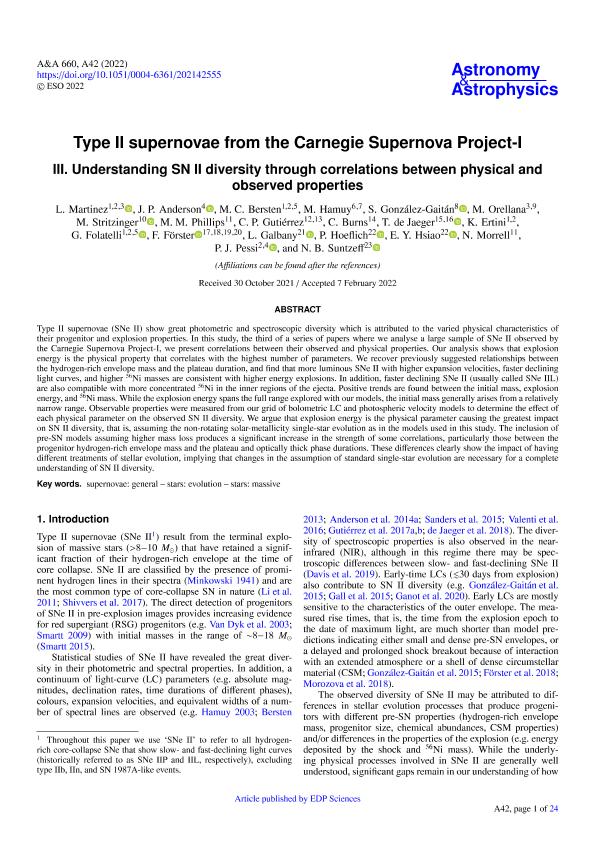Artículo
Type II supernovae from the Carnegie Supernova Project-I: III. Understanding SN II diversity through correlations between physical and observed properties
Martinez, Laureano ; Anderson, J. P.; Bersten, Melina Cecilia
; Anderson, J. P.; Bersten, Melina Cecilia ; Hamuy, Mario; González-Gaitán, S.; Orellana, M.; Stritzinger, M. D.; Phillips, M. M.; Gutiérrez, C. P.; Burns, C.; de Jaeger, T.; Ertini, Keila Yael
; Hamuy, Mario; González-Gaitán, S.; Orellana, M.; Stritzinger, M. D.; Phillips, M. M.; Gutiérrez, C. P.; Burns, C.; de Jaeger, T.; Ertini, Keila Yael ; Folatelli, Gaston
; Folatelli, Gaston ; Förster, F.; Galbany, Lluís; Hoeflich, Peter; Hsiao, Eric; Morrell, Nidia Irene
; Förster, F.; Galbany, Lluís; Hoeflich, Peter; Hsiao, Eric; Morrell, Nidia Irene ; Pessi, Priscila Jael
; Pessi, Priscila Jael ; Suntzeff, Nicholas B.
; Suntzeff, Nicholas B.
 ; Anderson, J. P.; Bersten, Melina Cecilia
; Anderson, J. P.; Bersten, Melina Cecilia ; Hamuy, Mario; González-Gaitán, S.; Orellana, M.; Stritzinger, M. D.; Phillips, M. M.; Gutiérrez, C. P.; Burns, C.; de Jaeger, T.; Ertini, Keila Yael
; Hamuy, Mario; González-Gaitán, S.; Orellana, M.; Stritzinger, M. D.; Phillips, M. M.; Gutiérrez, C. P.; Burns, C.; de Jaeger, T.; Ertini, Keila Yael ; Folatelli, Gaston
; Folatelli, Gaston ; Förster, F.; Galbany, Lluís; Hoeflich, Peter; Hsiao, Eric; Morrell, Nidia Irene
; Förster, F.; Galbany, Lluís; Hoeflich, Peter; Hsiao, Eric; Morrell, Nidia Irene ; Pessi, Priscila Jael
; Pessi, Priscila Jael ; Suntzeff, Nicholas B.
; Suntzeff, Nicholas B.
Fecha de publicación:
04/2022
Editorial:
EDP Sciences
Revista:
Astronomy and Astrophysics
ISSN:
0004-6361
Idioma:
Inglés
Tipo de recurso:
Artículo publicado
Clasificación temática:
Resumen
Type II supernovae (SNe II) show great photometric and spectroscopic diversity which is attributed to the varied physical characteristics of their progenitor and explosion properties. In this study, the third of a series of papers where we analyse a large sample of SNe II observed by the Carnegie Supernova Project-I, we present correlations between their observed and physical properties. Our analysis shows that explosion energy is the physical property that correlates with the highest number of parameters. We recover previously suggested relationships between the hydrogen-rich envelope mass and the plateau duration, and find that more luminous SNe II with higher expansion velocities, faster declining light curves, and higher 56Ni masses are consistent with higher energy explosions. In addition, faster declining SNe II (usually called SNe IIL) are also compatible with more concentrated 56Ni in the inner regions of the ejecta. Positive trends are found between the initial mass, explosion energy, and 56Ni mass. While the explosion energy spans the full range explored with our models, the initial mass generally arises from a relatively narrow range. Observable properties were measured from our grid of bolometric LC and photospheric velocity models to determine the effect of each physical parameter on the observed SN II diversity. We argue that explosion energy is the physical parameter causing the greatest impact on SN II diversity, that is, assuming the non-rotating solar-metallicity single-star evolution as in the models used in this study. The inclusion of pre-SN models assuming higher mass loss produces a significant increase in the strength of some correlations, particularly those between the progenitor hydrogen-rich envelope mass and the plateau and optically thick phase durations. These differences clearly show the impact of having different treatments of stellar evolution, implying that changes in the assumption of standard single-star evolution are necessary for a complete understanding of SN II diversity.
Palabras clave:
STARS: EVOLUTION
,
STARS: MASSIVE
,
SUPERNOVAE: GENERAL
Archivos asociados
Licencia
Identificadores
Colecciones
Articulos(IALP)
Articulos de INST.DE ASTROFISICA LA PLATA
Articulos de INST.DE ASTROFISICA LA PLATA
Citación
Martinez, Laureano; Anderson, J. P.; Bersten, Melina Cecilia; Hamuy, Mario; González-Gaitán, S.; et al.; Type II supernovae from the Carnegie Supernova Project-I: III. Understanding SN II diversity through correlations between physical and observed properties; EDP Sciences; Astronomy and Astrophysics; 660; A42; 4-2022; 1-24
Compartir
Altmétricas



